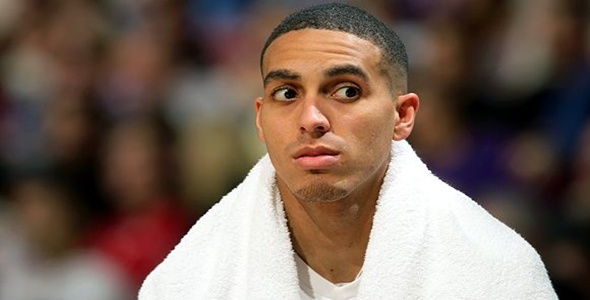While every quarterback prospect is unique and it’s difficult to assume one can develop into an already stable pro prospect, comparing quarterbacks to their ceilings (or their floors) can help prevent overeagerness in their value as well as rediscovered optimism in what they can become.By: Derrik Klassen
Paxton Lynch – supersized Tony Romo
With Romo being considerably smaller than Lynch, a lot of what Romo does looks quicker than Lynch, but their skill sets are largely the same. Both passers thrive underneath and can work timing routes well. They feel the pocket very well, showing plays where they shake defenders off in order to get out of the pocket and make a throw. Lynch’s game is built around keeping the ball safe and chipping away at defenses until he sees a big opportunity or the defense forces him to make a play in chaos, just as Romo has made a career out of.
Vernon Adams – Tyrod Taylor
Taylor was finally given a shot to be a starting quarterback last season and he shined. Adams is going to need someone to give him an opportunity, too, because many seem hesitant to do so right now. Adams is an excellent deep passer, as well as a deadly mobile passer. Like Taylor, Adams knows when to attack and when to move to the next play. Though, Adams already seems more confident over the middle of the field and better at maneuvering the pocket than Taylor, and Taylor is a good quarterback as is. Adams has the skills to be even better.
Connor Cook – Eli Manning
Quarterbacks are prone to getting overzealous and making dumb throws. The ones who can quickly forget those throws, bounce back and make great throws are worthwhile passers. Manning has been a rollercoaster of a passer throughout his career, but his peaks are as good as anyone’s and he always displays confidence in his top receiver. Cook had a similar dynamic at Michigan State, showing he could block out his poor decisions from earlier in the game to make big plays to win games. When these players are feeling it, they are as lethal as anyone.
Jared Goff – Sam Bradford
Bradford is just good enough at executing a system and working the middle of the field that he has kept himself relevant despite soon being on his 3rd team since 2010. He’s not a dynamic presence, he is robotic in the way he scans the field and he is not going to create offense in his own right. Goff is largely the same way. Goff even lacks the same physical tools Bradford does, sporting a thinner frame, less athleticism and a weaker arm. Goff is likely going to follow the same bounce-around career path that Bradford has.
Trevone Boykin – Jeff Garcia
Garcia made a solid career out of being a wild, mobile gunslinger. He had the movement in and out of the pocket to extend plays, just as he had the arm to make big throws all over the field. Boykin shares a lot of the same traits, including the same reckless gene that Garcia had. Boykin may not be a star, but he has more than enough playmaking ability to stick around.
Cardale Jones – Matt Stafford
Jones and Stafford highlight all the ups and downs of quarterback play. Both of them have a stunning arm to beat teams over the top and the poise/athleticism to make plays in or out of the pocket, but they are prone to head scratching plays. Whether it be a poor decision or a wildly inaccurate throw, Jones, like Stafford, has a lot of ugly looking plays. Though, their handful of flashes will always keep them around and make defenses fear them.
Carson Wentz – mobile Zach Mettenberger
Cementing one’s feet in the pocket and staring down receivers is a detrimental trait for NFL hopefuls. This is a common theme throughout Wentz’s tape, just as it was in Mettenberger’s LSU tape. Wentz, like Mettenberger, also fails to get the most out of his strong arm, struggling to hit receivers down the field and create explosive plays. Granted, Wentz is a much better athlete than Mettenberger was in the open field and can create yardage there, but they are near identical as passers.
Kevin Hogan – Ryan Lindley
Lindley isn’t special, but he’s proven to be a quality backup that can keep an offense alive and occasionally make a big play. He does not have the best arm, though, and has a low ceiling as a player. Hogan shares a lot of these traits and will prove to be an asset in the quarterback room, too. He can make enough accurate throws and has the confidence to stretch the field vertically. Hogan won’t be a long term starter, but he will be a long term NFL player.
Dak Prescott – Chad Henne
Henne’s Jacksonville days mostly consisted of three things: reckless first read throws, checkdowns and running for yardage. Prescott provides that same type of player, which is fine for a backup quarterback. They are accurate enough and understand that their job is to get the ball to skill players quickly, even if they force the ball in doing so. Prescott being a Henne level quarterback would allow him to collect a paycheck in the league for at least a few years.
Christian Hackenberg – Nick Foles
There was a time where Hackenberg seemed to be a great quarterback, but he has slowly devolved into Foles. Foles provides a vertical presence and enough athleticism to keep defenses on their toes, but he is generally inaccurate and struggles to gauge risky throws well. Hackenberg is a reckless passer, too, who has flashes of fitting the ball into tight windows. Hackenberg’s arm and confidence will keep him relevant, but it is hard to imagine him ever being what he was once thought to be.
Add The Sports Daily to your Google News Feed!
